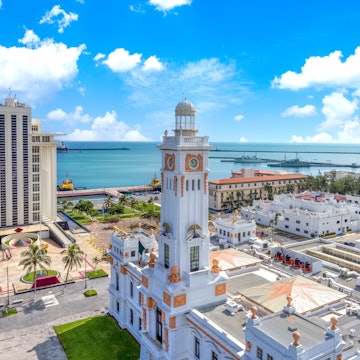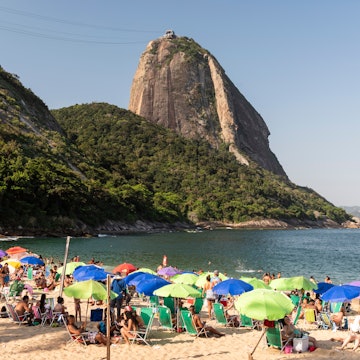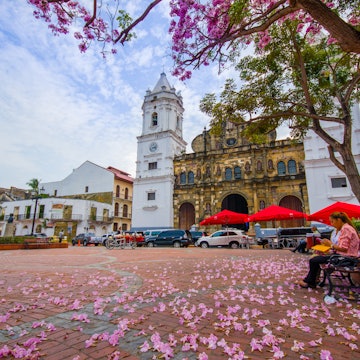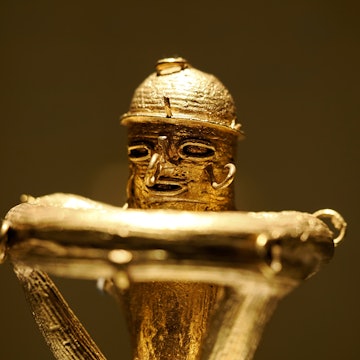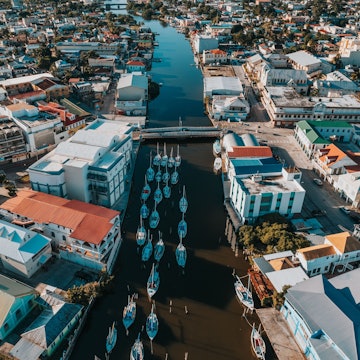
Panama City’s 5 best museums (and 6 best art galleries) offer a deeper understanding of the Central American destination

Aug 10, 2022 • 6 min read

These 11 institutions in Panama City are a great way of delving into Panamanian culture © Autumn Sky Photography / Shutterstock
Panama City’s museums explore the country’s natural and social history – worthwhile primers if you intend to get a deeper understanding of the Central American destination.
From honoring the contributions of immigrant labor on the canal to the emergence of the isthmus itself, Panama City’s museums cover a whole host of interesting topics. These are the best.
Museo de Arte Contemporáneo: best for contemporary art
Panama’s only art museum, the Museo de Arte Contemporáneo de Panamá (popularly known as MAC Panamá), has the largest collection of Panamanian art in the world. Founded as a non-profit NGO in 1962, the museum secured a permanent space in 1983 after purchasing and renovating the old Masonic Temple in the Canal Zone settlement of Ancón.
Today, the museum houses some 700 contemporary works by artists from across Latin America. Media include oil paintings, drawings, lithographs, photographs, sculptures, and ceramics.
In addition to hosting permanent and temporary exhibitions, it welcomes art students to attend workshops and talks (in Spanish). Its graphics laboratory is currently training new and emerging artists in traditional printmaking, and its library contains exhibit catalogs and volumes on Panamanian art.

BioMuseo: best for ecological history
The isthmus of Panama emerged from the ocean around 15 million years ago. First as a chain of volcanic islands, then as an unbroken, serpentine land bridge that united the American continents and divided the seas.
Designed by master architect Frank Gehry, the pioneering BioMuseo explores the significance of these events. Nestled on the canal’s edge on the Amador Causeway, the museum took 15 years to build from concept to opening in 2014. The Gehry signature rooftop is a haphazard, multi-colored jumble that symbolizes the natural world's diversity and the rainforest's staggered canopy.
The grounds include landscaped botanical gardens with shade, trails, and ponds where you might glimpse any of 153 bird or 291 butterfly species.
The BioMuseo is a giant art-science project which uses creative media to explore themes such as biodiversity, ecological interconnectedness, evolution, extinction, and deep time.
Exhibitions are divided into eight galleries designed by Bruce Mau in consultation with the Smithsonian Tropical Research Institute and the University of Panama.
Its gallery is dedicated to the Great Biotic Interchange – a mass migration event that transformed the biogeography of North and South America. It includes 97 life-size sculptures of prehistoric animals stampeding across the isthmus – look out for the mastodon and the giant ground sloth.

Weil Art Gallery and Galeria Arteconsult are among the top Panama City art galleries
Beyond MAC Panamá, a slew of chic galleries and stores represent the city's burgeoning art scene. Some reside in the newly gentrified historic quarter of Casco Viejo; others are hidden away in the glossy sprawl of the banking district. Plan your route carefully and always check opening times before setting out.
In the Bella Vista district, Weil Art Gallery is a buzzing contemporary gallery managed by Brazilian art dealer Carlos Weil. In Punta Paitilla, Galeria Arteconsult has been dealing in contemporary Latin American art for over three decades.
In Casco Viejo, Karavan stocks quality indigenous art and crafts. In Marbella, NG Gallery hosts several interesting artists from Cuba, like Jorge Otero and William Acosta. In El Cangrejo, Tamarindo is a contemporary art house with a stunning selection of pieces from Panamanian artists. The Cruz family owns the Marion Gallery in the San Francisco district. The family has deep roots in the Panama art world.
Afro-Antillean Museum of Panama: best for social history
Housed in a clapboard chapel built by Barbadian missionaries in 1910, the Afro-Antillean Museum of Panama tells the history of the Antillean immigrants who came to Panama in the 19th and 20th centuries.
Over several decades, tens of thousands of people migrated from the Caribbean to work on the railroad, the canal, and the United Fruit banana plantations of Bocas del Toro.
A so-called “Panama Man” was an island boy done good, but the reality of work on the mainland was harsh and unforgiving. Thousands of West Indian laborers, mostly Jamaicans, perished in the disastrous French effort to build the canal, resulting in an outbreak of malaria and yellow fever.
Health conditions improved under the Americans, but the canal company continued to operate a system of racial segregation. The museum honors and preserves the memory of the Afro-Antilleans who contributed so much to the construction and culture of Panama.
Exhibits include artifacts, historical photos, and mock-ups of a bedroom and kitchen that depict how immigrant canal workers lived.

Museo del Canal Interoceánico de Panamá: best for canal history
The Museo del Canal Interoceánico de Panamá overlooks the manicured gardens of Plaza de la Independencia, where Panama declared independence from Colombia in 1903.
The Roosevelt administration supported the rebellion and aided its victory with the US Navy gunboat, the USS Nashville, intervening to prevent Colombian forces from reaching Panama City.
A few weeks later, the US acquired the bankrupt French Canal Company and all their works, as well as a five-mile-wide strip of land across the isthmus, the Canal Zone, an unincorporated US territory and a de facto state within a state.
Located in the former 19th-century Grand Hotel, which served as the headquarters for both the French and American Canal Companies, the museum charts the historical evolution of Panama as a country of transit and transshipment.
Beginning with the transcontinental mule trains of the Spanish Empire, the museum guides visitors through the events that transformed the isthmus into a nexus of world trade.
Visitors learn about the construction of the Panama railroad, the French attempt to build the canal, and the subsequent American effort, concluding with the canal handover in 1999. Most exhibits are in Spanish, but English audio guides are available.

Museo de la Mola: best for Guna art
The small but brilliant Museo de la Mola explores the art and symbolism of the mola – a reverse appliqué textile made by Guna women. Traditional designs include psychedelic arrays of geometric shapes and abstract patterns that the Guna once tattooed on their bodies with jagua ink, much like the Emberá and Wounaan still do.
Modern mola designs include birds, animals, fish, mythical beings and totems, or even ships and planes. Molas are typically sewn onto the front and back of blouses (mola means “blouse" in the Duleyanga language). They can also be used as cushions or wall art.
Tips for buying molas
Molas are lightweight, non-fragile, and easy to pack – they make excellent souvenirs and personal gifts. Consisting of up to seven stacked layers of cloths, but usually three or four, each mola is cut to expose the design feature underneath it and the hem is then folded and sewn.
The mola is gradually built layer by layer. They can be machine-made in minutes or painstakingly rendered by hand over several months. Avoid molas with circles or triangles that have been added to fill space. Avoid molas whose colors have bleached in the sun. Always check the cloth quality of all layers.
The mola should not scrunch up when you run your hand over it. Stitching should be even and close and invisible from the front. Expect to pay between USD$20-50 for a decent, but basic mola measuring 30 by 44 cm (11X17 inches). The more layers, the higher the price; the very best cost hundreds of dollars.
Visit the Museo de la Mola before stocking up on molas. There are many places to buy them around the city, including Guna street vendors on the flower-festooned Paseo de las Bóvedas in Casco Viejo.







